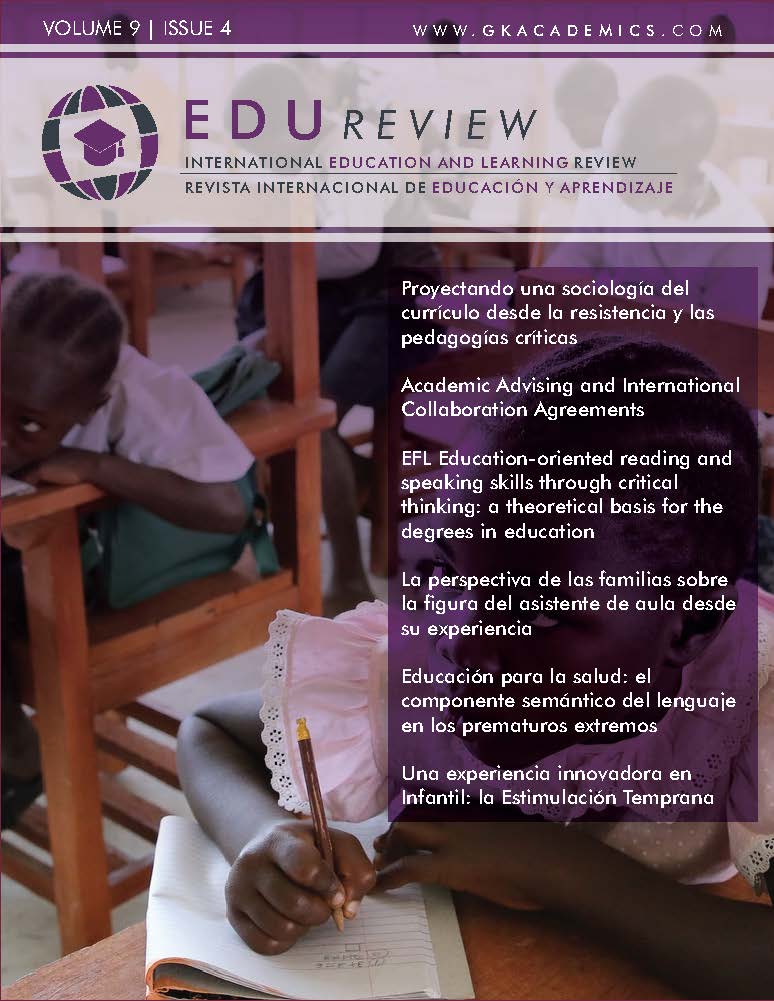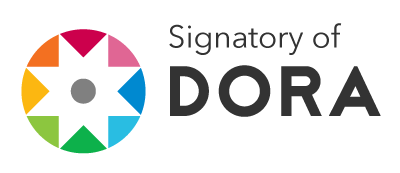The Perspective of the Families on the Figure of the Classroom Assistant from Their Experience
DOI:
https://doi.org/10.37467/gkarevedu.v9.3058Keywords:
Special needs assistants, Inclusion, Attention to diversity, NEE, Family, School, Qualitative researchAbstract
The aim of this research is to know, on the one hand, the bureaucratic limitations experienced by the families of students with educational needs to be attended by special needs assistants, and on the other hand, to know the potential of these interventions. A qualitative research has been developed with specific participants: eight families of students with educational needs who have been cared for by special needs assistants. The results show that the claims made by many families have contributed to sign a collaboration agreement and facilitate the presence of special needs assistants.
Downloads
Global Statistics ℹ️
|
554
Views
|
232
Downloads
|
|
786
Total
|
|
References
Albert M. J. A.G. (2007). La investigación educativa: Claves teóricas. McGraw-Hill.
Aranda, T. y Gomes Araújo, E. (2009). Técnicas e instrumentos cualitativos de recogida de datos. En A. Pantoja Vallejo (coord.), Manual básico para la realización de tesinas, tesis y trabajos de investigación (273-300). EOS.
Barbour, R. (2013). Los grupos de discusión en investigación cualitativa. Madrid: Morata.
Biggs, E.E., Carter, E.W., Bumble, J.L., Barnes, K. y Mazur, E.L. (2018). Enhancing peer network interventions for students with complex communication needs. Exceptional Children, 85, 66–85. doi:10.1177/0014402918792899
Brown, T. S. y T. L. Stanton-Chapman. (2017). Experiences of Paraprofessionals in US Preschool Special Education and General Education Classrooms. Journal of Research in Special Educational Needs 17(1), 18–30. doi:10.1111/1471-3802.12095
Cardona, C. M. (2005). Diversidad y Educación Inclusiva: Enfoques metodológicos y estrategias para una enseñanza colaborativa. Pearson-Prentice Hall.
Cole-Lade, G.M. y Bailey, L.E. (2020). Examining the role of paraeducators when supporting children with complex communication needs: A multiple case study. Teacher Education and Special Education, 43(2), 144-161. doi:10.1177/0888406419852778
Chopra, R.V., y French, N.K. (2004). Paraeducator relationships with parents of students with significant disabilities. Remedial and Special Education, 25(4), 240-251. doi:10.1177/07419325040250040701
Chopra, R.V. y Giangreco, M.F. (2019). Effective use of teacher assistants in inclusive classrooms. En M. J. Schuelka, C. Johnstone, G. Thomas y A. J. Artiles (Eds), The SAGE Handbook of inclusión and diversity in education. (pp. 193-207). SAGE Publications
Duk, C. y Murillo, F.J. (2016). La inclusión como dilema. Revista latinoamericana de educación inclusiva, 10(1), 11-14. doi:10.4067/S0718-73782016000100001
Durán, D., y Giné, C. (2011). La formación del profesorado para la educación inclusiva: Un proceso de desarrollo profesional y de mejora de los centros para atender la diversidad. Revista Latinoamericana de Educación inclusiva, 5(2), 153-170. Recuperado de: http://www.repositoriocdpd.net:8080/handle/123456789/1913
Echeita G. y Ainscow, M. (2011). La educación inclusiva como derecho. Marco de referencia y pautas de acción para el desarrollo de una revolución pendiente. Tejuelo: Didáctica de la Lengua y la Literatura, 12, 26-46. Recuperado de: https://tejuelo.unex.es/article/view/2497/1635
Echeita, G. (2013). Inclusión y exclusión educativa. De nuevo “voz y quebranto”. REICE. Revista electrónica iberoamericana sobre calidad, eficacia y cambio en educación, 6(2), 9-18. Recuperado de: http://hdl.handle.net/10486/661466
Echeita, G. (2016). Educación para la inclusión o educación sin exclusiones. Narcea Ediciones.
Escobar, J. y Bonilla-Jiménez, F.I. (2009). Grupos focales: una guía conceptual y metodológica. Cuadernos hispanoamericanos de psicología, 9(1), 51-67. Recuperado de: http://biblioteca.udgvirtual.udg.mx/jspui/handle/123456789/957
Fisher, M., y Pleasants, S.L. (2012). Roles, responsibilities, and concerns of paraeducators: Findings from a statewide survey. Remedial and Special Education, 33(5), 287-297. doi:10.1177/0741932510397762
Flick, U. (2009). Introducción a la investigación cualitativa. Morata
Giangreco, M.F. (2010). Utilization of teacher assistants in inclusive schools: Is it the kind of help that helping isa ll about? European journal of special needs education, 25(4), 341-345. doi:10.1080/08856257.2010.513537
Gibbs, G. (2012). El análisis de datos cualitativos en investigación cualitativa. Morata.
González, B. A., Cortés, P. G. y Mañas, M. O. (2020). La inclusión educativa a través de la narrativa-biográfica. Experiencias del profesorado de pedagogía terapeútica. Revista Infancia, Educación y Aprendizaje, 6(1), 19-36.
González, B. A., Cortés, P. y Rivas, J. I. F. (2020). Experiencia Escolar, Diversidad y Ciudadanía Justa. Un Estudio Biográfico-Narrativo. Revista Internacional de Educación para la Justicia Social, 9(1), 41-58. doi:10.15366/riejs2020.9.1.002
Inostroza-Barahona, C. y Lohaus-Reyes, M.F. (2019). Inclusión y diversidad: Nuevos desafíos para la política curricular chilena. Reflexiones desde la teoría curricular y la justicia social. Revista Internacional de Educación para la Justicia Social, 9, 151-162. Doi:10.15366/riejs2019.8.1.009
Jacobo, S. (2012). Percepción de los padres de familia sobre la influencia de la maestra sombra en los niños con diferencias de aprendizaje [Tesis de Grado]. Universidad Rafael Landivar.
Jardí, A., Puigdellívol, I. y Petreñas, C. (2018). Teacher assistants’ roles in Catalan classrooms: promoting fair and inclusion-oriented support for all. International Journal of Inclusive Education, 1-16. Doi:10.1080/13603116.2018.1545876
Kvale, S. (2011). Las entrevistas en Investigación Cualitativa. Morata.
Lee, B. 2003. Teaching assistants in schools: The current state of play. Education Journal, (68), 25–27.
Ley Orgánica 2/2006, de 3 de mayo, de Educación (LOE), Boletín Oficial del Estado, 106, de 4 de mayo de 2006, 17158 a 17205. Recuperado de https://www.boe.es/boe/dias/2006/05/04/pdfs/A17158-17207.pdf
Ley Orgánica 3/2020, de 29 de diciembre, por la que se modifica la Ley Orgánica 2/2006, de 3 de mayo, de Educación (LOMLOE), Boletín Oficial del Estado, 340, de 30 de diciembre de 2020, 122868 a 122953. Recuperado de https://www.boe.es/boe/dias/2020/12/30/pdfs/BOE-A-2020-17264.pdf
Ley Orgánica 8/2013, de 9 de diciembre, para la Mejora de la Calidad Educativa (LOMCE), Boletín Oficial del Estado, 295, de 10 de diciembre de 2013, 97858 a 97921. Recuperado de http://www.boe.es/boe/dias/2013/12/10/pdfs/BOE-A-2013-12886.pdf
López-Vélez, A. L. (2018). La escuela inclusiva: el derecho a la equidad y la excelencia educativa. Euskal Herriko Unibertsitatea: Servicio Editorial de la Universidad del País Vasco.
Meléndez, Lady. (2006). El docente de apoyo educativo de cara a las políticas de inclusión social en América Latina. En memorias: III Congreso internacional de discapacidad. Inclusión: oportunidad para todos. Medellín, Colombia, p. 110-119.
Murillo, F. J. y Hernández-Castilla, R. (2014). Liderando escuelas justas para la justicia social. Revista Internacional de Educación para la Justicia Social, 3(4), 13-32. Recuperado de: http://hdl.handle.net/10486/666733
Orozco, I., y Moriña, A. (2020). Estrategias Metodológicas que Promueven la Inclusión en Educación Infantil, Primaria y Secundaria. Revista Internacional de Educación para la Justicia Social, 9(1), 81-98. doi:10.15366/riejs2020.9.1.04
Sheehey, P.H., Wells, J.C., y Ogata, V.F. (2018). Paraeducators’perceptions and experiences working with diverse families. Rural Special Education Quarterly, 37(1), 44-51. doi:10.1177/8756870517741890
Sinisi, L. (2010). Integración o inclusión escolar. ¿Un cambio de paradigma? Boletín de Antropología y Educación, 1, 11-14. Recuperado de: http://antropologia.institutos.filo.uba.ar/sites/antropologia.institutos.filo.uba.ar/files/bae_n01a02.pdf
Stainback, S. y Stainback, W. (1999). Aulas inclusivas. Un nuevo modo de enfocar y vivir el currículo. Narcea ediciones.
Stake, R.E. (1998). Investigación con estudio de casos. Morata.
Stewart, E.M. (2019). Reducing ambiguity: Tools to define and communicate paraprofessional roles and responsibilities. Intervention in School and Clinic, 55(1), 52-57. doi:10.177/1053451218782431
Sulaiman, N.F., Rasit, H.H., Toran, H., y Abdullah, N. (2019). Parents Satisfaction with Services Provided by Shadow Aides in an Inclusive Classroom. En 3rd International Conference on Special Education (ICSE 2019) (pp. 181-184). Atlantis Press.
Takala, M. (2007). The work of classroom assistants in special and mainstream education in Finland. British journal of special education, 34(1), 50-57. Doi:10.1111/j.1467-8578.2007.00453.x
Verger, S., Chover, L. y Rosselló, M.R. (2020). La contribución del/de la auxiliar técnico educativo (ATE) para el desarrollo de una plena inclusión. Aula Abierta, 49(2), 171-176. Doi:10.17811/rifie.492.2020.171-176
Downloads
Published
How to Cite
Issue
Section
License
Those authors who publish in this journal accept the following terms:
-
Authors retain copyright.
-
Authors transfer to the journal the right of first publication. The journal also owns the publishing rights.
-
All published contents are governed by an Attribution-NoDerivatives 4.0 International License.
Access the informative version and legal text of the license. By virtue of this, third parties are allowed to use what is published as long as they mention the authorship of the work and the first publication in this journal. If you transform the material, you may not distribute the modified work. -
Authors may make other independent and additional contractual arrangements for non-exclusive distribution of the version of the article published in this journal (e.g., inclusion in an institutional repository or publication in a book) as long as they clearly indicate that the work was first published in this journal.
- Authors are allowed and recommended to publish their work on the Internet (for example on institutional and personal websites), following the publication of, and referencing the journal, as this could lead to constructive exchanges and a more extensive and quick circulation of published works (see The Effect of Open Access).













